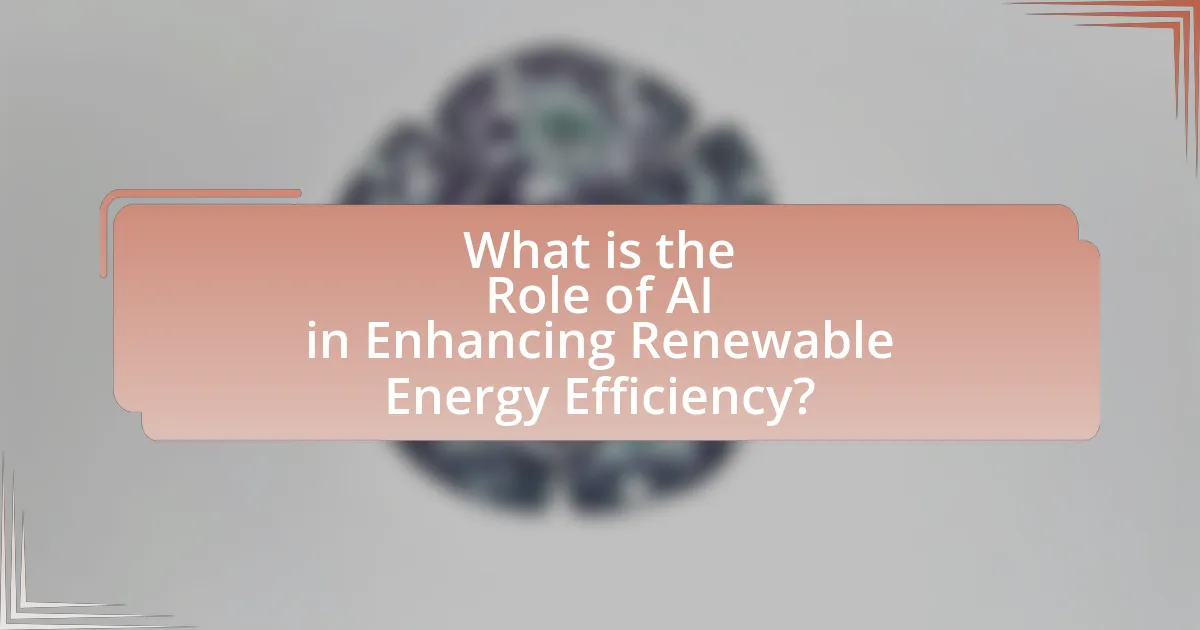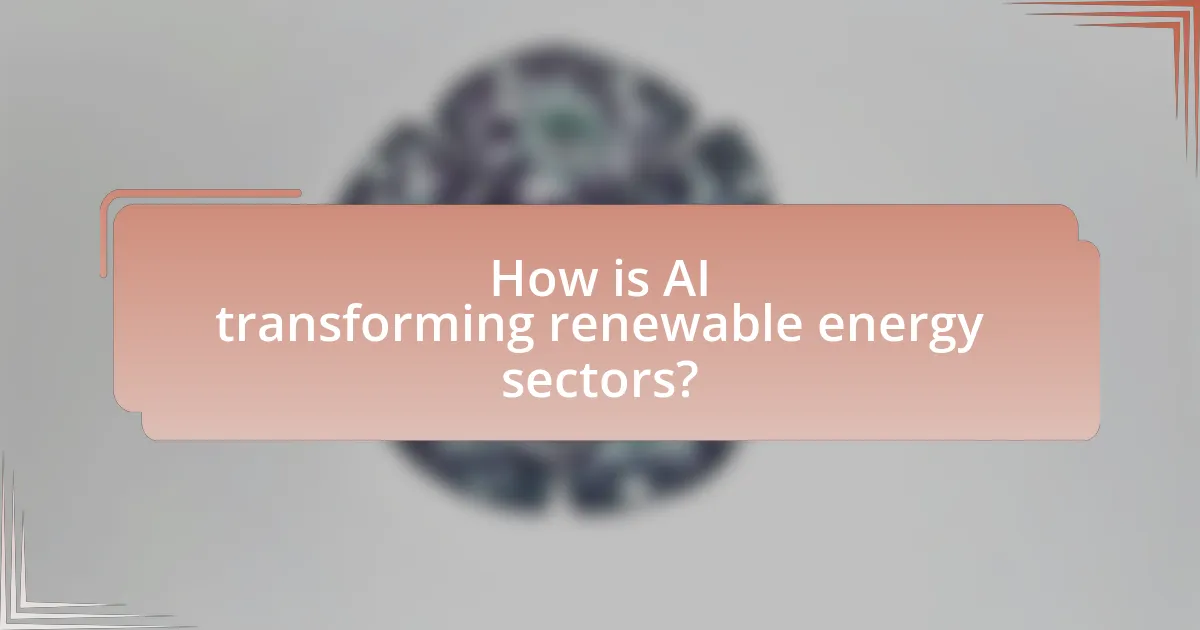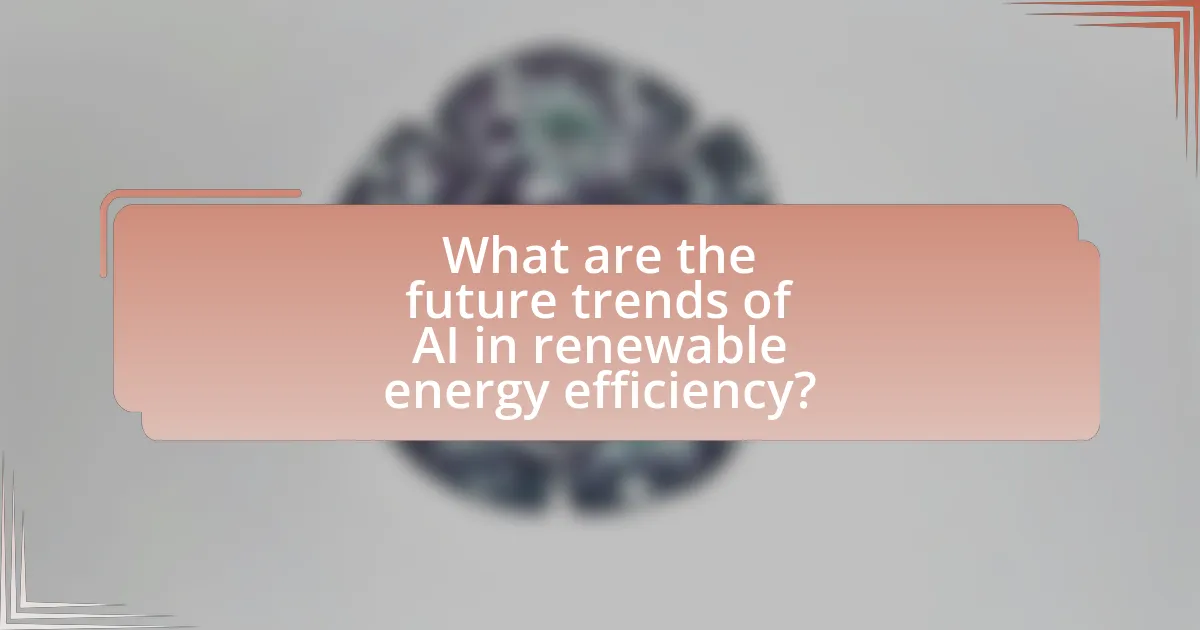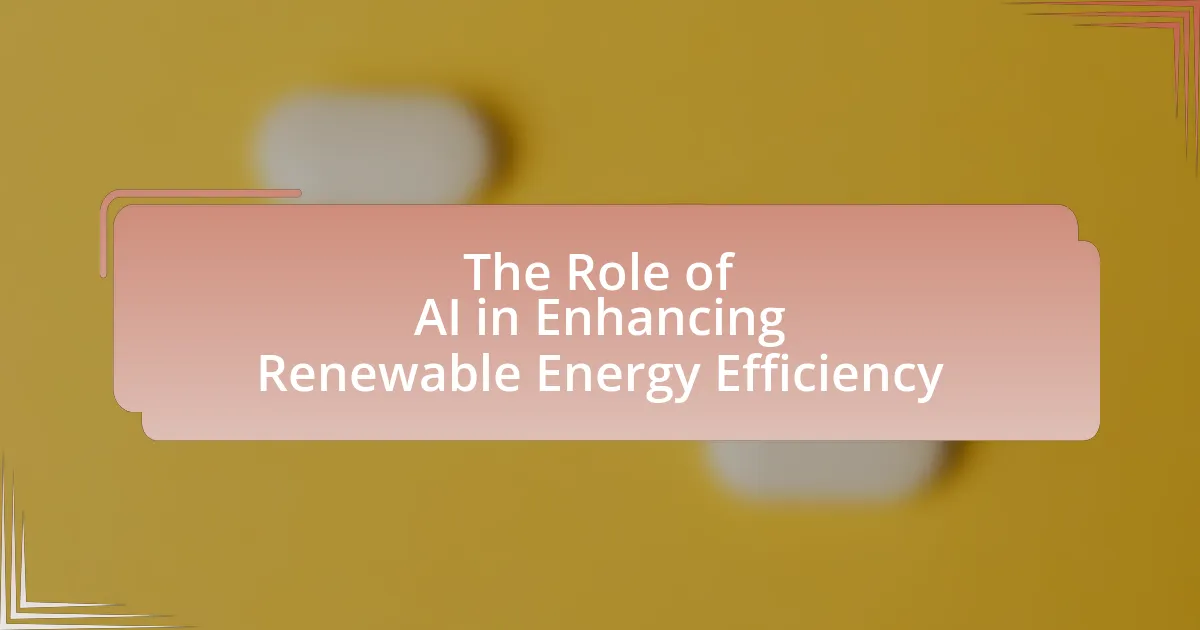The article focuses on the role of artificial intelligence (AI) in enhancing renewable energy efficiency. It outlines how AI optimizes energy production and consumption through predictive analytics and real-time data processing, leading to significant improvements in energy output and operational costs. Key technologies such as machine learning algorithms and Internet of Things (IoT) devices are discussed, highlighting their contributions to energy management, forecasting, and grid stability. The article also addresses the benefits of AI integration in renewable energy systems, including increased efficiency, reduced operational costs, and enhanced predictive maintenance, while identifying future trends and best practices for successful AI implementation in the sector.

What is the Role of AI in Enhancing Renewable Energy Efficiency?
AI plays a crucial role in enhancing renewable energy efficiency by optimizing energy production and consumption through predictive analytics and real-time data processing. For instance, AI algorithms analyze weather patterns and energy demand to improve the performance of solar panels and wind turbines, leading to a reported increase in energy output by up to 20% in some cases. Additionally, AI-driven energy management systems can reduce waste by optimizing grid operations and integrating renewable sources more effectively, which has been shown to lower operational costs by approximately 10-15%. These advancements demonstrate that AI significantly contributes to maximizing the efficiency and reliability of renewable energy systems.
How does AI contribute to renewable energy systems?
AI enhances renewable energy systems by optimizing energy production, improving grid management, and facilitating predictive maintenance. For instance, machine learning algorithms analyze weather patterns and historical data to forecast energy generation from sources like solar and wind, leading to more efficient energy dispatch. Additionally, AI-driven systems can manage energy distribution in real-time, balancing supply and demand to reduce waste and enhance grid stability. Research from the International Renewable Energy Agency indicates that AI can increase the efficiency of renewable energy systems by up to 30%, demonstrating its significant impact on the sector.
What specific technologies enable AI’s role in renewable energy?
Specific technologies that enable AI’s role in renewable energy include machine learning algorithms, predictive analytics, and Internet of Things (IoT) devices. Machine learning algorithms analyze vast datasets to optimize energy production and consumption, while predictive analytics forecast energy demand and supply fluctuations, enhancing grid management. IoT devices facilitate real-time monitoring and data collection from renewable energy sources, enabling AI systems to make informed decisions. For instance, a study by the International Renewable Energy Agency (IRENA) highlights that AI can improve solar energy output predictions by up to 30%, demonstrating its effectiveness in enhancing renewable energy efficiency.
How does AI optimize energy production and consumption?
AI optimizes energy production and consumption by utilizing advanced algorithms to predict energy demand and manage supply efficiently. For instance, machine learning models analyze historical consumption data and weather patterns to forecast energy needs, allowing for better alignment of energy generation with demand. Additionally, AI systems can optimize the operation of renewable energy sources, such as wind and solar, by adjusting output based on real-time conditions, thereby reducing waste and enhancing grid stability. Research from the International Renewable Energy Agency indicates that AI can improve energy efficiency by up to 20% in various sectors, demonstrating its significant impact on optimizing energy systems.
What are the key benefits of integrating AI in renewable energy?
Integrating AI in renewable energy significantly enhances efficiency, optimizes resource management, and improves predictive maintenance. AI algorithms analyze vast datasets from renewable sources, such as solar and wind, to forecast energy production and demand accurately. For instance, a study by the International Renewable Energy Agency (IRENA) found that AI can increase the efficiency of solar energy systems by up to 20% through improved tracking and forecasting. Additionally, AI-driven predictive maintenance reduces downtime and operational costs by identifying potential failures before they occur, leading to a more reliable energy supply.
How does AI improve energy forecasting and management?
AI improves energy forecasting and management by utilizing advanced algorithms and machine learning techniques to analyze vast amounts of data, leading to more accurate predictions of energy demand and supply. For instance, AI can process historical consumption patterns, weather data, and real-time information to optimize energy distribution and reduce waste. Research from the International Energy Agency indicates that AI can enhance forecasting accuracy by up to 30%, enabling better decision-making for energy providers and consumers alike. This improved accuracy helps in balancing energy loads, integrating renewable sources more effectively, and ultimately contributing to a more efficient energy system.
What impact does AI have on reducing operational costs?
AI significantly reduces operational costs by optimizing processes and improving efficiency in various sectors, including renewable energy. For instance, AI algorithms can analyze vast amounts of data to predict equipment failures, allowing for proactive maintenance that minimizes downtime and repair costs. A study by McKinsey & Company found that AI can reduce operational costs by up to 20% in manufacturing through enhanced predictive maintenance and process optimization. Additionally, AI-driven energy management systems can optimize energy consumption, leading to lower utility bills and reduced waste. These applications demonstrate that AI not only streamlines operations but also leads to substantial cost savings across industries.

How is AI transforming renewable energy sectors?
AI is transforming renewable energy sectors by optimizing energy production, enhancing grid management, and improving predictive maintenance. For instance, AI algorithms analyze weather patterns and historical data to forecast energy generation from sources like solar and wind, leading to more efficient energy dispatch. According to a report by the International Renewable Energy Agency, AI can increase renewable energy output by up to 20% through better forecasting and resource management. Additionally, AI-driven systems can monitor and predict equipment failures, reducing downtime and maintenance costs, which is crucial for maintaining the efficiency of renewable energy installations.
What applications of AI are most prevalent in renewable energy?
The most prevalent applications of AI in renewable energy include predictive maintenance, energy management systems, and optimization of energy production. Predictive maintenance utilizes AI algorithms to analyze data from equipment, enabling timely repairs and reducing downtime, which is crucial for maintaining efficiency in wind turbines and solar panels. Energy management systems leverage AI to forecast energy demand and supply, allowing for better integration of renewable sources into the grid. Additionally, optimization techniques powered by AI enhance the performance of renewable energy systems by adjusting operational parameters in real-time, leading to increased energy output and reduced costs. These applications are supported by industry reports indicating that AI can improve operational efficiency by up to 20% in renewable energy sectors.
How is AI used in solar energy systems?
AI is used in solar energy systems primarily for optimizing energy production and improving system efficiency. By analyzing vast amounts of data from weather patterns, solar irradiance, and energy consumption, AI algorithms can predict energy output and adjust operations in real-time. For instance, machine learning models can forecast solar panel performance based on historical data, leading to better maintenance schedules and reduced downtime. Additionally, AI-driven energy management systems can optimize the integration of solar energy with other power sources, enhancing grid stability and reducing reliance on fossil fuels. Studies have shown that AI can increase solar energy efficiency by up to 20% through these predictive and adaptive capabilities.
What role does AI play in wind energy optimization?
AI plays a crucial role in wind energy optimization by enhancing predictive maintenance, improving energy forecasting, and optimizing turbine performance. Through machine learning algorithms, AI analyzes vast datasets from wind turbines to predict failures before they occur, thereby reducing downtime and maintenance costs. For instance, a study by the National Renewable Energy Laboratory found that predictive maintenance can reduce operational costs by up to 30%. Additionally, AI improves energy forecasting accuracy by analyzing weather patterns and historical data, which helps in better grid management and energy distribution. This optimization leads to increased efficiency and reliability in wind energy production.
How does AI enhance grid management and stability?
AI enhances grid management and stability by optimizing energy distribution and predicting demand fluctuations. Through advanced algorithms and machine learning, AI analyzes vast amounts of data from various sources, enabling real-time decision-making that improves the reliability of power supply. For instance, AI can forecast energy demand with up to 95% accuracy, allowing grid operators to adjust supply proactively, thus reducing the risk of outages. Additionally, AI facilitates the integration of renewable energy sources by managing their variability, ensuring a balanced grid that can accommodate fluctuating energy inputs. This capability is crucial as renewable energy sources like solar and wind are inherently intermittent, and AI’s predictive analytics help maintain grid stability despite these challenges.
What are the challenges AI addresses in grid integration?
AI addresses several challenges in grid integration, including the management of variable renewable energy sources, optimization of energy distribution, and enhancement of grid reliability. Specifically, AI algorithms can predict energy generation from sources like solar and wind, which are inherently intermittent, thus allowing for better planning and integration into the grid. Additionally, AI can optimize the distribution of energy by analyzing consumption patterns and adjusting supply accordingly, which improves efficiency and reduces waste. Furthermore, AI enhances grid reliability by detecting anomalies and predicting failures, enabling proactive maintenance and reducing downtime. These capabilities are supported by data from various studies, such as the International Energy Agency’s report on AI’s impact on energy systems, which highlights the effectiveness of AI in improving grid management and renewable energy integration.
How does AI facilitate demand response in energy systems?
AI facilitates demand response in energy systems by optimizing energy consumption patterns through real-time data analysis and predictive modeling. By leveraging machine learning algorithms, AI can analyze historical consumption data, weather forecasts, and grid conditions to predict peak demand periods. This enables utilities to incentivize consumers to reduce or shift their energy usage during high-demand times, thereby balancing supply and demand more effectively. For instance, a study by the U.S. Department of Energy found that AI-driven demand response programs can reduce peak load by up to 20%, significantly enhancing grid reliability and efficiency.

What are the future trends of AI in renewable energy efficiency?
Future trends of AI in renewable energy efficiency include enhanced predictive analytics, optimized energy management systems, and improved integration of renewable sources into the grid. AI algorithms will increasingly analyze vast datasets to forecast energy demand and supply, enabling more efficient resource allocation. For instance, a study by the International Renewable Energy Agency (IRENA) indicates that AI can reduce energy consumption in buildings by up to 30% through smart energy management. Additionally, AI will facilitate real-time monitoring and maintenance of renewable energy systems, leading to increased operational efficiency and reduced downtime. These advancements will ultimately contribute to a more sustainable and resilient energy infrastructure.
How will advancements in AI technology impact renewable energy?
Advancements in AI technology will significantly enhance the efficiency and integration of renewable energy systems. AI algorithms can optimize energy production by predicting weather patterns, which allows for better management of resources like solar and wind energy. For instance, a study by the National Renewable Energy Laboratory found that AI can improve the forecasting of renewable energy generation by up to 30%, leading to more effective grid management and reduced reliance on fossil fuels. Additionally, AI-driven analytics can optimize energy consumption in real-time, further increasing the efficiency of renewable energy systems.
What emerging AI technologies are expected to influence the sector?
Emerging AI technologies expected to influence the renewable energy sector include machine learning algorithms, predictive analytics, and autonomous systems. Machine learning algorithms enhance energy management by optimizing grid operations and predicting energy demand patterns, which can lead to more efficient energy distribution. Predictive analytics allows for better forecasting of renewable energy generation, such as solar and wind, by analyzing weather data and historical performance, thereby improving reliability and integration into the grid. Autonomous systems, including drones and robots, are increasingly used for maintenance and monitoring of renewable energy installations, reducing operational costs and improving safety. These technologies collectively contribute to increased efficiency and sustainability in renewable energy systems.
How can AI contribute to achieving sustainability goals?
AI can significantly contribute to achieving sustainability goals by optimizing energy consumption and enhancing the efficiency of renewable energy systems. For instance, AI algorithms can analyze vast amounts of data from energy grids to predict demand and supply fluctuations, enabling better integration of renewable sources like solar and wind. According to a report by the International Renewable Energy Agency, AI can improve energy efficiency by up to 30% in various sectors, thus reducing greenhouse gas emissions and promoting sustainable practices. Additionally, AI-driven predictive maintenance can extend the lifespan of renewable energy infrastructure, further supporting sustainability objectives.
What best practices should be followed when implementing AI in renewable energy?
Best practices for implementing AI in renewable energy include ensuring data quality, integrating AI with existing systems, and focusing on scalability. High-quality data is essential for accurate AI predictions and optimizations, as demonstrated by studies showing that data-driven models can improve energy forecasting accuracy by up to 30%. Integrating AI with existing energy management systems allows for seamless operation and enhances decision-making processes. Additionally, designing AI solutions with scalability in mind ensures that they can adapt to increasing data volumes and complexity, which is crucial as the renewable energy sector continues to grow.
How can organizations ensure successful AI integration?
Organizations can ensure successful AI integration by establishing a clear strategy that aligns AI initiatives with business objectives. This involves assessing current capabilities, identifying specific use cases for AI, and fostering a culture of collaboration among stakeholders. Research indicates that companies with a defined AI strategy are 2.5 times more likely to achieve significant improvements in operational efficiency (McKinsey & Company, 2021). Additionally, investing in training and development for employees enhances their ability to work effectively with AI technologies, further supporting successful integration.
What common pitfalls should be avoided in AI deployment?
Common pitfalls to avoid in AI deployment include inadequate data quality, lack of clear objectives, and insufficient stakeholder engagement. Inadequate data quality can lead to biased models and inaccurate predictions, as demonstrated by a study from MIT, which found that poor data quality can reduce model performance by up to 50%. Lack of clear objectives results in misaligned efforts and wasted resources; organizations must define specific goals to guide AI initiatives effectively. Insufficient stakeholder engagement can lead to resistance and lack of adoption, as highlighted by a McKinsey report indicating that projects with strong stakeholder involvement are 2.5 times more likely to succeed. Addressing these pitfalls is crucial for successful AI integration in enhancing renewable energy efficiency.


